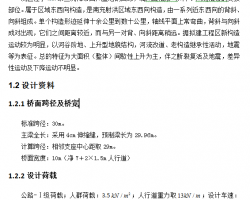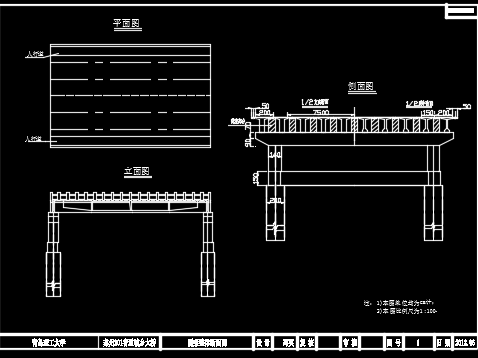论文关键词:桥梁设计 隔震设计
Paper keywords: isolation design of bridge design
论文摘要:近年来我国城市交通事业迅猛发展,桥梁在城市发展中的作用日益显现和提高,因此客观上要求桥梁抗震效能的增强与改善。本文从三个方面来介绍桥梁设计中的隔震设计:第一部分强调了加强桥梁隔震设计的重要性,第二部分介绍了桥梁隔震设计的相关理论,在第三部分着重介绍了桥梁隔震设计的方法。
Abstract: in recent years the rapid development of urban traffic in China, a bridge in a more important role in urban development and improve, thus is necessary for bridge seismic performance of strengthened and improved. This article from three aspects to introduce the aseismic design of bridge design: the first part emphasizes the importance of strengthening bridge isolation design, the second part introduces the theory about the design of bridge isolation, in the third part emphatically introduces the design of bridge isolation method.
桥梁是现代城市化建设中的重要基础设施,它具有极强的社会公共性,建设时其投资较大且后期运营管理中也相对困难。另外桥梁作为危机管理系统的重要构成部分,应当具备较强的抗震性能,因为桥梁抗震性能的提高可以有效地减少地震后的损失。
Bridge is an important infrastructure of modern urbanization construction, it has extremely strong social public, when its construction investment is larger and the late operation management is also relatively difficult. Another bridge as the important part of the crisis management system, should have better seismic performance, because the bridge seismic performance improvement can effectively reduce earthquake damage.
1 桥梁进行隔震设计的好处和重要性
1 the benefits and the importance of bridge vibration isolation design
1.1 桥梁隔震设计的重要性
1.1 the importance of bridge seismic isolation design
桥梁设计中的隔震设计指的是在桥梁建设时安装隔震器,它可以使桥梁在水平方向上得到柔性支承,这样就使水平方向上的周期延长,另外还要安装阻尼器来,这样做是为了提高桥梁的阻尼效应,可以再地震发生时降低地震的作用。
Bridge in the design of vibration isolation design refers to the installation of isolation device in bridge construction, it can make bridge is a flexible supporting on a horizontal direction, thus prolongs the period that horizontally, in addition to install dampers, this was done in order to improve the damping effect of bridge, can reduce the earthquake effect at the time of the earthquake.
近些年,国外一些发达国际在桥梁的隔震设计方面加强了研究取得了很多重大的突破。但我国在这些方面还比较落后,研究还处于初级阶段且缺乏系统性,主要一些方法大多采用国外的研究经验和成果。
In recent years, foreign some advanced international in aseismic design of Bridges strengthened research has achieved many significant breakthrough. But in these aspects are relatively backward in our country, the research is still in its infancy and lack of systematic, some main methods mostly adopt the abroad research experience and results.
1.2 桥梁隔震设计的好处
The benefits of 1.2 bridge isolation design
在桥梁的设计中加强隔震设计,可以有效地改善和分解地震后的地震力在各结构支座间力的分布情况,这样可以保护桥梁的基础部位,同时对桥梁的上部结构可以有效地支撑和保护。
, in the design of bridge strengthening isolation design can effectively improve and break down after the earthquake of the earthquake force between each structural bearing force distribution, this can protect the bridge site, the basis of the upper structure of bridge can be effectively supported and protected.
在桥梁设计中的相关隔震设计可起到调节横向刚度的作用,这样可以改善桥梁结构扭转平衡的问题,有效地降低了地震力。
In the bridge design related isolation design can rise to adjust the action of lateral stiffness, so that we can improve the problem in bridge structure torsion balance, effectively reduce the seismic forces.
在桥梁设计中的上部结构时,采用隔震减少甚至消除地震后桥梁的上下部结构出现的超出建设弹性范围的现象, 防止超出弹性范围后局部部位发生变形。
Upper structure in the bridge design, the isolation to reduce or even eliminate the top and bottom of the bridge structure after earthquake phenomenon beyond the construction elasticity, prevent deformation in local area beyond the elastic range.
在桥梁设计中进行隔震系统的设计,可以取得比普通抗震设计更好的抗震效能,这样就在不增加工程造价的情况下,还提高了工程的质量。
In bridge design for the design of vibration isolation system, the better seismic performance than ordinary seismic design can be obtained, thus under the condition of without increasing the project cost, also improve the quality of the project.
在桥梁的隔震设计中采用的隔震支座若在正常使用条件下,由于温度的变化或者其它的形变而发生变化,它们的形变相对也较小,这样就能为城市建设中高架桥梁设计中多跨连续梁桥的采用,即减小伸缩缝的使用提供了方便。
Used in aseismic design of Bridges if isolation bearings under the condition of normal use, due to the deformation of temperature change or other changes, their deformation is relatively small, so it can help in the design of elevated Bridges of urban construction of multi-span continuous girder bridge adopting, namely reduce the expansion joints used provides a convenient.
与那些未采用隔震设计的桥梁相比较,采用了隔震设计的桥梁可以在经历了较大的地震后,较容易地更换隔震设计和装置,且维修的时间相对较短,维修的费用也相对较低。
And those who do not adopt the vibration isolation design of the bridge, the vibration isolation design of the bridge can after a major earthquake, more easily to replace isolation design and device, and relatively short maintenance time, maintenance costs are relatively low.
2 桥梁隔震设计理论概述
Introduction to the theory of bridge vibration isolation design
2.1 隔震技术的原理
2.1 the principle of isolation technology
隔震是抗震方式发展的一种新形式和新趋势,它的作用是通过减小而并非抵抗地震的作用来起到桥梁的保护结构不受损、桥梁的抗震能力增强的效果。在通常的桥梁设计和施工中,提高桥梁抗震效果的方法通常是通过提高桥梁结构的整体强度和变形能力。与之相对比,桥梁的隔震设计主要特点在于引入了柔性装置的设计,这样做就使桥梁的重要结构构件可以与水平地面运动在一定程度上的关联性减少,使重要构件在地震后不会发生破坏性的损伤,使结构的反应加速度比地面的加速度小,另外,由于采用了阻尼设计,这样阻尼就有效地将地震带来的能量得到消耗,当能量传递到桥梁上部以及隔震结构时作用力已大大减小。
Isolation is a seismic method in the development of a new form and new trend, its role is not to resist earthquake by reducing effect for the protection of the bridge structure is damaged, Bridges aseismatic ability enhancement effect. In usually bridge design and construction, improve the effect of bridge seismic method is usually by increasing the overall strength and deformation capacity of bridge structure. In contrast ratio, bridge vibration isolation design of the main characteristic is that the introduction of flexible device design, doing so can make bridge the important structural components and reduce the correlation of horizontal ground motion to a certain extent, and make important component not destructive damage after the earthquake, the structure is smaller than the ground acceleration response acceleration, in addition, due to the damping design is adopted, so that damping is brought by the earthquake energy consumption effectively, when the energy transfer to the upper bridge and structure force has been greatly reduced.
2.2 隔震技术的特点
2.2 the characteristics of the isolation technology
隔震技术在桥梁抗震设计中的的应用,主要目的就是为了利用这些隔震装置达到延长结构周期、消耗地震能量和降低地震后结构毁坏和变化的效果。在桥梁进行隔震设计时,最关键的因素就是要求要有合理的设计,使相关的抗震系统构件能够具有较强的弹性和可塑性。
Isolation technology in application of bridge seismic design, the main purpose is to prolong the cycle structure using the isolation device, the structure of the seismic energy consumption and reduce the earthquake damage and the effect of the change. In the vibration isolation design of a bridge, the most critical factor is required to have reasonable design, make relevant seismic system components can has strong elasticity and plasticity.
隔震技术在桥梁设计中的采用,一方面可起到减少工程造价同时提高工程效能的效果,它往往要比常规的抗震设计的抗震性能高,可以有效地保护桥梁墩柱,达到降低桥梁墩柱延性需求的作用和目的;另一方面上部结构中隔震措施的采用可以有效地减小或者消除地震后桥梁的下部结构超出弹性范围的反映和现象,对于那些在地震后难以检查或者修复的地方,隔震设计可以避免在这些部位发生严重的非弹性变形。
Isolation technology is adopted in the bridge design, on the one hand, can reduce the project cost at the same time, increase the efficiency of the engineering effect, it often is better than the conventional seismic design of high seismic performance, can effectively protect the bridge pier, decrease the function and purpose of bridge pier ductility demand; On the other hand isolation measures adopted in the upper structure can effectively reduce or eliminate Bridges after the earthquake the lower part of the structure beyond the reflect and phenomenon of elastic range, for those who after the earthquake is difficult to check or repair, isolation design can avoid serious inelastic deformation in these areas.
2.3 桥梁隔震设计的基本原则
2.3 the basic principles of bridge seismic isolation design
桥梁隔震设计是加强桥梁抗震性能的重要要求,但在进行隔震设计时应当遵守以下几个基本原则,只有认真遵守这些原则,才能有效地、切实地提高桥梁抗震效能,这些原则分别是:
Bridge seismic isolation design is the important requirement of strengthening the seismic performance of Bridges, but in the vibration isolation design shall comply with the following fundamental principles, only seriously abide by these principles, in order to effectively and effectively increase the efficiency of the bridge anti-earthquake and these principles are:
应对桥梁是否适宜采用隔震设计进行科学的考察,考察应当以其周期增长后系统能否有效地提高地震时能量的吸收,且以这个为判断的判据。对于不适合进行抗震结构的桥梁地段,不能盲目地进行施工。
Response to suitability of bridge vibration isolation design for scientific investigation, inspection shall be based on the growth cycle after the system can effectively improve the absorption of energy, when the earthquake and based on this criterion of judgment. For bridge location is not suitable for aseismatic structure, can not blindly to construction.
隔震装置在桥梁设计中若被采用,则它的上部结构在地震后会产生相对的位移,这将对桥梁的后期使用和功能产生影响,因此在地震后,应当加强对隔震装置的修补和完善。
Isolation devices, if used in the bridge design, it's the upper structure will produce relative displacement after the earthquake, this will affect the later use of bridge and function, so after the quake, should strengthen the repair for the vibration isolation device and perfect.
若在桥梁设计时采用了相关的隔震措施,那么应当保证桥梁的抗震性能不低于那些采用普通抗震设计所起到的抗震性能的大小。
If during the design of a bridge USES the related isolation measures, it shall guarantee the seismic performance of Bridges is not lower than those using ordinary seismic design, the seismic performance of a size.
应当对采用隔震措施桥梁附近的地质环境以及桥梁地基进行科学地研究和勘测,隔震桥梁附近应当具有较为坚实的地质条件。
Shall adopt isolation measures bridge near the geological environment and bridge foundation for scientific research and exploration, near base-isolated Bridges should have solid geological conditions.
在采用隔震装置时,应当尽可能地选择和采用那些结构简单且同时符合所需隔震性能的装置,且应当保证在其力学性能的范围内科学地采用。
When using isolation device, should choose as far as possible and adopt the structure is simple and conforms to the required isolation performance of the device at the same time, and shall guarantee the USES in the scope of its mechanical properties of internal medicine.
3 桥梁的隔震设计
3 bridge isolation design
3.1 隔震装置的设计
3.1 design of vibration isolation device
隔震装置的设计和结构其它构件的设计是隔震桥梁抗震设计的两个主要方面。隔震装置的设计是隔震设计的中心,当前,在桥梁的隔震设计中较为普遍采用的方法是弹性反应谱法,这种方法被大部分国家采用,但有不同的规范,主要有美国的、日本的和欧洲的规范,它们之间区别不大,主要在于计算公式的不同,这些计算公式是指隔震装置等效刚度的计算和和等效阻尼的计算,与之相对比,那些复杂性强或较为不规则的桥梁,较为常用的方法是时程方法。
Isolation device design and structure design is the isolation of other components are two major aspects of bridge seismic design. Isolation device design is the center of the vibration isolation design, currently, are common used in aseismic design of Bridges is elastic response spectrum method, the method adopted by most countries, but have different specifications, are mainly in the United States, Japan and European standards, the difference between them is not big, mainly lies in the calculation formula is different, the calculation formula is refers to the calculation of equivalent stiffness and vibration isolation device and the calculation of equivalent damping, in contrast, the strong complexity and more irregular bridge, is more commonly used method when cheng.
弹性反应谱方法之所以得到普遍采用,一方面是因为施工时计算的相对简单,另一方面是因为它和现有的规范计算方法很接近,这样便易于接受,最后应当引起注意的是众所周知隔震装置的等效刚度和等效阻尼的计算是与隔震装置在地震中的最大变形程度有关的,继而隔震装置的变形又与整个桥梁的地震响应程度有关系,所以客观上要求我们对于采用弹性反应谱方法进行的隔震设计应当是一个不断完善和变化的过程。由于在具体的计算中,对于目标的实现和达到没有直接的公式可采用,因此这就要求设计人员对桥梁结构地震响应的程度有较好的掌握和预估,地震发生后,较为熟练的工程师可以依据其长期工作的经验初步地制定设计方案,方案完成后,再用一系列的时程来分析和验证其设计是否合理。
Elastic response spectrum method is widely used, on the one hand, because of construction when the calculation is relatively simple, on the other hand because of it and the existing calculation method of the specification is very close, so easy to accept, and finally should cause attention is known as the equivalent stiffness and equivalent damping of vibration isolation device is calculated with isolation device in the largest earthquake deformation degree, deformation and isolation device and has relations with the degree of seismic response of the bridge, so it is necessary for us for the elastic response spectrum method for the isolation of design should be a process of constantly improve and change. Because in the calculation of concrete, for the realization of the goal and achieve no formula can be used directly, so it requires designers to the degree of the earthquake response of the bridge structure has better mastery and forecast, after the earthquake, the more skilled engineers can be based on the long-term working experience in set up a preliminary design scheme, and scheme is completed, with a series of time history to analyze and verify the design is reasonable.
3.2 细部构造的设计
3.2 detail structure design
桥梁的附属结构在桥梁的隔震设计中同样发挥着巨大的作用,这些附属结构和构件主要包括限位装置、伸缩缝、防落梁装置等,通过对诸多震害调查的分析和动力时程分析我们发现这些细部构造是影响桥梁结构动力响应和隔震效果的重要方面。但当前普遍存在的问题是大多数的设计人员会忽略细部构造的设计、将其置于次要地位,另外一方面这也是由于在地震响应的计算时附属结构的计算方法较为复杂造成的。在细部构件的设计时应当具有良好的连续性。
Bridge of adjacent structures in bridge seismic isolation design also plays a huge role, the adjacent structures and components mainly including spacing device, expansion joints, prevent fall beam device, etc., through the analysis of many earthquake damage investigation and dynamic time history analysis we found that these detail structure affect the bridge structure is the important aspect of dynamic response and vibration isolation effect. But the common problem is that most designers will ignore the detail structure design, to place it in the secondary position, on the other hand this is because in the calculation method of seismic response calculation attached structure is relatively complex. In the detail components when the design should have good continuity.
4 结束语
4 conclusion
桥梁设计中的隔震设计是提高桥梁工程质量的重要方面,虽然目前我国的隔震技术还处于初级阶段,但我们应当科学地吸收和借鉴国外的一些技术经验,完善我国国内桥梁设计中的隔震设计,提高桥梁的抗震性能。
Bridge in the design of vibration isolation design are important aspects to improve the quality of bridge engineering, although at present our country of the isolation technology is still in its infancy, but we should scientifically some technology to absorb and draw lessons from foreign experience, consummates our country domestic isolation design of bridge design, improve the seismic performance of Bridges.





